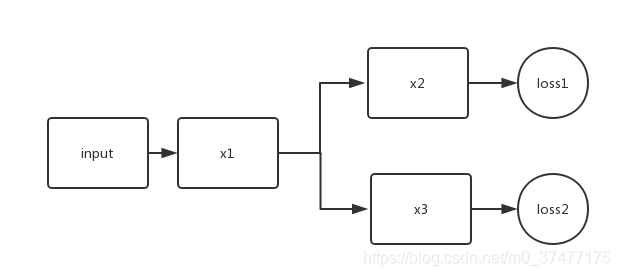溫馨提示×
您好,登錄后才能下訂單哦!
點擊 登錄注冊 即表示同意《億速云用戶服務條款》
您好,登錄后才能下訂單哦!
這篇文章將為大家詳細講解有關keras多任務多loss回傳的示例分析,小編覺得挺實用的,因此分享給大家做個參考,希望大家閱讀完這篇文章后可以有所收獲。
如果有一個多任務多loss的網絡,那么在訓練時,loss是如何工作的呢?
model = Model(inputs = input, outputs = [y1, y2]) l1 = 0.5 l2 = 0.3 model.compile(loss = [loss1, loss2], loss_weights=[l1, l2], ...)
final_loss = l1 * loss1 + l2 * loss2
我們最終的優化效果是最小化final_loss。
問題來了,在訓練過程中,是否loss2只更新得到y2的網絡通路,還是loss2會更新所有的網絡層呢?
此問題的關鍵在梯度回傳上,即反向傳播算法。


所以loss1只對x1和x2有影響,而loss2只對x1和x3有影響。
補充:keras 多個LOSS總和定義

用字典形式,名字是模型中輸出那一層的名字,這里的loss可以是自己定義的,也可是自帶的
補充:keras實戰-多類別分割loss實現
本文樣例均為3d數據的onehot標簽形式,即y_true(batch_size,x,y,z,class_num)
def dice_coef_fun(smooth=1): def dice_coef(y_true, y_pred): #求得每個sample的每個類的dice intersection = K.sum(y_true * y_pred, axis=(1,2,3)) union = K.sum(y_true, axis=(1,2,3)) + K.sum(y_pred, axis=(1,2,3)) sample_dices=(2. * intersection + smooth) / (union + smooth) #一維數組 為各個類別的dice #求得每個類的dice dices=K.mean(sample_dices,axis=0) return K.mean(dices) #所有類別dice求平均的dice return dice_coef def dice_coef_loss_fun(smooth=0): def dice_coef_loss(y_true,y_pred): return 1-1-dice_coef_fun(smooth=smooth)(y_true=y_true,y_pred=y_pred) return dice_coef_loss
def generalized_dice_coef_fun(smooth=0): def generalized_dice(y_true, y_pred): # Compute weights: "the contribution of each label is corrected by the inverse of its volume" w = K.sum(y_true, axis=(0, 1, 2, 3)) w = 1 / (w ** 2 + 0.00001) # w為各個類別的權重,占比越大,權重越小 # Compute gen dice coef: numerator = y_true * y_pred numerator = w * K.sum(numerator, axis=(0, 1, 2, 3)) numerator = K.sum(numerator) denominator = y_true + y_pred denominator = w * K.sum(denominator, axis=(0, 1, 2, 3)) denominator = K.sum(denominator) gen_dice_coef = numerator / denominator return 2 * gen_dice_coef return generalized_dice def generalized_dice_loss_fun(smooth=0): def generalized_dice_loss(y_true,y_pred): return 1 - generalized_dice_coef_fun(smooth=smooth)(y_true=y_true,y_pred=y_pred) return generalized_dice_loss
# Ref: salehi17, "Twersky loss function for image segmentation using 3D FCDN" # -> the score is computed for each class separately and then summed # alpha=beta=0.5 : dice coefficient # alpha=beta=1 : tanimoto coefficient (also known as jaccard) # alpha+beta=1 : produces set of F*-scores # implemented by E. Moebel, 06/04/18 def tversky_coef_fun(alpha,beta): def tversky_coef(y_true, y_pred): p0 = y_pred # proba that voxels are class i p1 = 1 - y_pred # proba that voxels are not class i g0 = y_true g1 = 1 - y_true # 求得每個sample的每個類的dice num = K.sum(p0 * g0, axis=( 1, 2, 3)) den = num + alpha * K.sum(p0 * g1,axis= ( 1, 2, 3)) + beta * K.sum(p1 * g0, axis=( 1, 2, 3)) T = num / den #[batch_size,class_num] # 求得每個類的dice dices=K.mean(T,axis=0) #[class_num] return K.mean(dices) return tversky_coef def tversky_coef_loss_fun(alpha,beta): def tversky_coef_loss(y_true,y_pred): return 1-tversky_coef_fun(alpha=alpha,beta=beta)(y_true=y_true,y_pred=y_pred) return tversky_coef_loss
def IoU_fun(eps=1e-6): def IoU(y_true, y_pred): # if np.max(y_true) == 0.0: # return IoU(1-y_true, 1-y_pred) ## empty image; calc IoU of zeros intersection = K.sum(y_true * y_pred, axis=[1,2,3]) union = K.sum(y_true, axis=[1,2,3]) + K.sum(y_pred, axis=[1,2,3]) - intersection # ious=K.mean((intersection + eps) / (union + eps),axis=0) return K.mean(ious) return IoU def IoU_loss_fun(eps=1e-6): def IoU_loss(y_true,y_pred): return 1-IoU_fun(eps=eps)(y_true=y_true,y_pred=y_pred) return IoU_loss
關于“keras多任務多loss回傳的示例分析”這篇文章就分享到這里了,希望以上內容可以對大家有一定的幫助,使各位可以學到更多知識,如果覺得文章不錯,請把它分享出去讓更多的人看到。
免責聲明:本站發布的內容(圖片、視頻和文字)以原創、轉載和分享為主,文章觀點不代表本網站立場,如果涉及侵權請聯系站長郵箱:is@yisu.com進行舉報,并提供相關證據,一經查實,將立刻刪除涉嫌侵權內容。